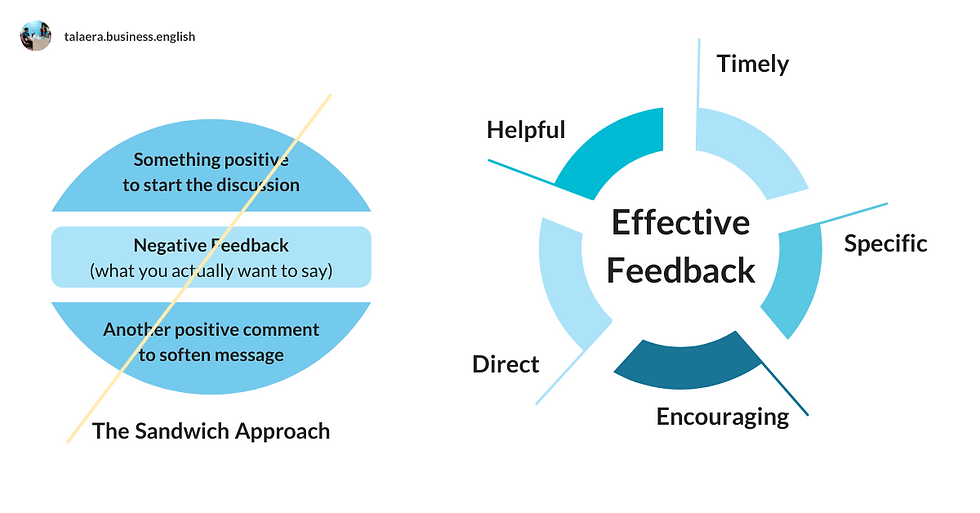How To Give Constructive Feedback So Others Actually Want To Act On It
- Paola Pascual

- Oct 6, 2021
- 7 min read
Updated: Feb 3

Regardless of your role or seniority, you’re likely to lead, help with, and comment on other people’s performance in some capacity or another. Whether you are a native-English speaker or you speak it as a second language, giving feedback can be tricky.
Giving feedback in a way that makes others actually want to act on it is an art only a few have managed to master. I surely still have much to learn, but after over a decade of working with professionals from far and wide, I have noticed some patterns. These patterns tend to be helpful pretty much everywhere across the globe, and I’d like to share them with you.
How To Give Constructive Feedback
Constructive feedback is supportive feedback that you provide with the aim of helping others make the most of their abilities. Its main goal is to help others improve or build (construct) effective skills and behaviors.
For feedback to be constructive and effective –understanding effective as making the other person actually want to act on it–, it needs to be polite. Not only that, but it also needs to be helpful, timely, specific, encouraging, and direct. Let’s look at these 5 adjectives and how you can achieve them when providing feedback to a colleague or an employee.
1. Helpful
Your main goal when providing feedback should be for it to be helpful. It is crucial that your advice is well thought through, and the first step you should think about is: “What is the goal of this feedback?” It should come from a humble place, and you should care personally. You can avoid sounding patronizing by offering support and framing it as something beneficial, not as an attack.
2. Timely
Find the right moment to provide feedback. If the other person is in a delicate or emotional situation, it might not be the right time. It should be soon after the situation has happened, but if needed, wait until the other person is emotionally ready to receive your feedback (as) objectively (as possible).
3. Specific
The more specific, the better. Your feedback should focus on things that can be controlled. It’s not about them intrinsically, it’s about what they did or how they reacted. For this, it is important to discern between the behavior and the person -and always focus on the former.
Compare “He is so unprofessional” with “He’s been late 3 days this week”. In the first sentence, there is no clear reason why the person might be unprofessional or whether he can change it or not. In the second example, on the contrary, it is apparent that the problem is his repeated tardiness, which can be fixed by coming in earlier.
The SBI Feedback Model –Situation, Behavior, Impact– can help you spell out the issue at hand in a more specific way. Describe the situation. Be specific about when and where it happened. Describe the observable behavior, that is, only what you were able to see directly. Avoid making assumptions about what they might have thought or what motives they might have. Then, communicate the impact or results of the behavior in an objective way (would 5 other people say this is happening the same way?).
4. Encouraging
Give feedback with a growth mindset approach. A growth mindset consists of believing that skills can be improved with time and effort. It’s about valuing passion for growth, grit, and collaboration. Someone with a growth mindset does not think that talent is innate or something to worship, but rather something you need to work for.
With this in mind, you should provide feedback that encourages growth and willingness to improve things. One way to do this is by asking questions such as: What’s your take on this situation? How could we avoid this in the future? Is there a way I/we can help you improve?
You may also make your feedback more encouraging by doing it publicly if it is positive, and privately if it is negative.
5. Direct
Ditch the “Sandwich Approach”. If you have provided negative feedback between two pieces of positive feedback, you have used this approach before. Some leaders think that people will accept negative feedback better when they receive it with positive feedback. Others think that this approach reduces discomfort and anxiety. However, many argue that the “Sandwich Approach” actually undermines your feedback.

If you want to change someone’s behavior or help them improve, at some point, you will need to embrace the discomfort and offer clear, honest feedback. Needless to say, it should always be polite. Never mistake directness for rudeness.
Giving Constructive Feedback: 1 Thing You Might Be Forgetting
Communicating feedback (especially negative feedback) should always be done in a polite way. I am fairly confident that most people will agree with that. However, here’s one thing you might be forgetting: Politeness is in the eye of the beholder. When it comes to evaluating others, culture plays a major role. What for one culture sounds polite and subtle might feel false and confusing for another. What one culture sees as clear and honest, another might feel like a brutal slap in the face. This happens, to a large extent, because different cultures have different communication styles and ways to give feedback.
Direct cultures (such as Israel, the Netherlands, or Germany) tend to provide feedback honestly and bluntly. Negative messages do not need to be softened by positive ones, and they tend to use absolute descriptors when criticizing. These are called upgraders (e.g. totally inappropriate, or completely unprofessional). For example: “Our podcast intro is absolutely outdated. I suggest we do this.”
Indirect cultures (such as Japan, Korea, or Indonesia) tend to provide feedback in a much more subtle and diplomatic way. They often use downgraders – words that soften criticism (e.g. kind of, sort of, a bit, a little, maybe, slightly, perhaps). If we take the previous example, an indirect culture might express it like this: “I thought we might possibly consider updating our podcast intro, perhaps?”
Look at this other example included in The Culture Map: “In Germany, we typically use strong words when complaining or criticizing in order to make sure the message registers clearly and honestly. Of course, we assume others will do the same. My British boss during a one-on-one “suggested that I think about” doing something differently. So I took his suggestion: I thought about it and decided not to do it. Little did I know that his phrase was supposed to be interpreted as “change your behavior right away or else.” And I can tell you I was pretty surprised when my boss called me into his office to chew me out for insubordination!”
Is It Possible To Stay Polite Across Cultures?
As you see, these cultural differences can lead to both misunderstandings and hurt feelings. So, is there anything you can do to provide constructive criticism that is always polite across cultures? The first thing you should do is invest time and effort in building good relationships with those you work with. Get to know them better and understand how they like to receive feedback. Once you understand this, you may want to adapt and test the waters before openly speaking up.
Related episode: How Different Cultures Say No – Talaera Talks Podcast
If you come from a rather direct culture and you are communicating with a person from a more indirect one, you may want to add some downgraders or sprinkle in some positive messages to soften the message. This doesn’t mean that you should sugar-coat anything. You should still be direct and explicit in most cases, but don’t jump into the negatives straight away. Start by expressing those things you do admire or appreciate about the person’s actions or reactions.
On the other hand, if you would like to give corrective feedback to a person from a culture that is more direct than yours, be careful! If you try to do it like them, you can miss the mark. Even if the other person appreciates direct, honest feedback, you can be too direct. To avoid going too far, you can start by dropping some downgraders or removing double meanings.
Another great tip is to communicate to people how you usually give feedback before giving them the feedback itself. You can say “When I give feedback I usually do/say XYZ, just so you are aware. I know it may sound a bit ABC, but I don’t want to confuse you.” Having this type of conversation may feel awkward initially, but it is a great way to set expectations and build strong relationships with those around you.
The first step is to work on your Cultural Intelligence (CQ). If you are interested in learning the nuances of cross-cultural communication, Erin Meyer explains it masterfully in her book The Culture Map. If you work in a multicultural environment, Talaera can help you bridge the gap. Our teachers specialize in cross-cultural communication and will be able to help you and your teams work more effectively and united.
Keep Working on your Cross-Cultural Communication Skills
Develop cross-cultural intelligence (CQ), address cross-cultural struggles, and improve collaboration across cultures. Work 1:1 with an expert instructor, explore scalable communications training for your teams, and make the most of our free resources.
For any additional information or questions, you can also reach out at hello@talaera.com. Interested in getting the best offers and receiving free content on Business English communication? Subscribe to our newsletter and we will keep you in the loop with offers, free events, and development materials!
If you enjoyed this article, keep reading:
What Americans Really Mean When They Say Things Like “How Are You?”
Working With Israelis? Use These 6 Excellent Communication Tips
The 6 Communication Tips Everyone Working With Germans Should Know
A Quick Guide To Asking Better Questions In Cross Cultural Workplaces
8 Tips On Direct Communication For Those Who Were Called “Too Direct”
13 Ways to Break Down Silos in the Workplace And Boost Collaboration
9 Tell-Tale Signs Your Employees Are Struggling With Cross-Cultural Communication
How To Overcome The Top 4 Communication Barriers In The Workplace




